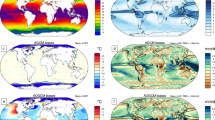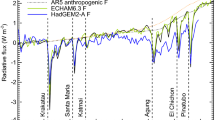Abstract
Experiments with abrupt CO2 forcing allow the diagnosis of the response of global mean temperature and precipitation in terms of fast temperature independent adjustments and slow, linear temperature-dependent feedbacks. Here we compare responses, feedbacks and forcings in experiments performed as part of version 5 of the coupled model inter-comparison project (CMIP5). The experiments facilitate, for the first time, a comparison of fully coupled atmosphere-ocean general circulation models (GCM’s) under both linearly increasing and abrupt radiative forcing. In the case of a 1 % per year compounded increase in CO2 concentration, we find that the non-linear evolution of surface air temperature in time, when combined with the linear evolution of the radiative balance at the top of the atmosphere, results in a feedback parameter and effective climate sensitivity having an offset compared to values computed from abrupt 4× CO2 forcing experiments. The linear evolution of the radiative balance at the top of the atmosphere also contributes to an offset between the global mean precipitation response predicted in the 1 % experiment using linear theory and that diagnosed from the experiments themselves, and a potential error between the adjusted radiative forcing and that produced using a standard linear formula. The non-linear evolution of temperature and precipitation responses are also evident in the RCP8.5 scenario and have implications for understanding, quantifying and emulating the global response of the CMIP5 climate GCMs.





Similar content being viewed by others
References
Andrews T, Forster P (2008) CO2 forcing induces semi-direct effects with consequences for climate feedback interpretations. Geophys Res Lett 35:L04802
Andrews T, Forster P, Gregory J (2009) A surface energy perspective on climate change. J Clim 22(10):2557–2570
Andrews T, Forster P, Boucher O, Bellouin N, Jones A (2010) Precipitation, radiative forcing and global temperature change. Geophys Res Lett 37(14):L14701
Andrews T, Gregory J, Webb M, Taylor K (2012a) Forcing, feedbacks and climate sensitivity in CMIP5 coupled atmosphere–ocean climate models. Geophys Res Lett 39(9):L09712
Andrews T, Gregory J, Forster P, Webb M (2012b) Cloud adjustment and its role in CO2 radiative forcing and climate sensitivity: a review. Surv Geophy 33(3):619–635
Colman R (2003) A comparison of climate feedbacks in general circulation models. Clim Dyn 20(7):865–873
Colman R, McAvaney B (2011) On tropospheric adjustment to forcing and climate feedbacks. Clim Dyn 36(9):1649–1658
Forster P, Taylor K (2006) Climate forcings and climate sensitivities diagnosed from coupled climate model integrations. J Clim 19(23):6181–6194
Good P, Gregory J, Lowe J (2011) A step-response simple climate model to reconstruct and interpret AOGCM projections. Geophys Res Lett 38(1):L01703
Good P, Gregory J, Lowe J, Andrews T (2012) Abrupt CO2 experiments as tools for predicting and understanding CMIP5 representative concentration pathway projections. Clim Dyn 36(9):1649–1658
Good P, Ingram W, Lambert F, Lowe J, Gregory M, Webb M, Ringer M, Wu P (2012) A step-response approach for predicting and understanding non-linear precipitation changes. Clim Dyn 39(12):2789–2803
Gregory J, Mitchell J (1997) The climate response to CO2 of the Hadley Centre coupled AOGCM with and without flux adjustment. Geophys Res Lett 24(15):1943–1946
Gregory J, Webb M (2008) Tropospheric adjustment induces a cloud component in CO2 forcing. J Clim 21(1):58–71
Gregory J, Forster P (2008) Transient climate response estimated from radiative forcing and observed temperature change. J Geophys Res Atmos 113(D23):58–71
Gregory J, Ingram W, Palmer M, Jones G, Stott P, Thorpe R, Lowe J, Johns T, Williams K (2004) A new method for diagnosing radiative forcing and climate sensitivity. Geophys Res Lett 31(3):L03205
Harris G, Sexton D, Booth B, Collins M, Murphy J, Webb M (2006) Frequency distributions of transient regional climate change from perturbed physics ensembles of general circulation model simulations. Clim Dyn 27(4):357–375
Huntingford C, Cox P (2000) An analogue model to derive additional climate change scenarios from existing gcm simulations. Clim Dyn 16(8):575–586
Keen A, Murphy J (1997) Influence of natural variability and the cold start problem on the simulated transient response to increasing CO2. Clim Dyn 13(12):847–864
Kiehl J, Shields C, Hack J, Collins W (2006) The climate sensitivity of the community climate system model version 3 (ccsm3). J Clim 19(11):2584–2596
Lambert F, Allen M (2009) Are changes in global precipitation constrained by the tropospheric energy budget? J Clim 22(3):499–517
Lambert F, Webb M (2008) Dependency of global mean precipitation on surface temperature. Geophys Res Lett 35(16):L16706
Murphy J (1995) Transient response of the Hadley Centre coupled ocean-atmosphere model to increasing carbon dioxide. III: analysis of global-mean response using simple models. J Clim 8(3):496–514
Murphy J, Sexton D, Barnett D, Jones G, Webb M, Collins M, Stainforth D (2004) Quantification of modelling uncertainties in a large ensemble of climate change simulations. Nature 430(7001):768–772
Myhre G, Highwood E, Shine K, Stordal F (1998) New estimates of radiative forcing due to well mixed greenhouse gases. Geophys Res Lett 25(14):2715–2718
Raper S, Gregory J, Stouffer R (2002) The role of climate sensitivity and ocean heat uptake on aogcm transient temperature response. J Clim 15(1):124–130
Senior C, Mitchell J (2000) Time-dependence of climate sensitivity. Geophys Res Lett 27(17):2685–2688
Soden B, Held I (2006) An assessment of climate feedbacks in coupled ocean-atmosphere models. J Clim 19(14):3354–3360
Stouffer R, Manabe S (1999) Response of a coupled ocean–atmosphere model to increasing atmospheric carbon dioxide: sensitivity to the rate of increase. J Clim 12(8):2224–2237
Taylor K, Stouffer R, Meehl G (2007) A summary of the cmip5 experiment design. World 4:1–33
Webb M, Senior C, Sexton D, Ingram W, Williams K, Ringer M, McAvaney B, Colman R, Soden B, Gudgel R et al (2006) On the contribution of local feedback mechanisms to the range of climate sensitivity in two GCM ensembles. Clim Dyn 27(1):17–38
Williams K, Ingram W, Gregory J (2008) Time variation of effective climate sensitivity in gcms. J Clim 21(19):5076–5090
Yokohata T, Emori S, Nozawa T, Ogura T, Kawamiya M, Tsushima Y, Suzuki T, Yukimoto S, Abe-Ouchi A, Hasumi H et al (2008) Comparison of equilibrium and transient responses to CO2 increase in eight state-of-the-art climate models. Tellus A 60(5):946–961
Acknowledgments
This work was funded by the UK Natural Environment Research Council under the Changing Water Cycle Programme PAGODA project NE/I006524/1. We thank Theo Economou for advice on statistical matters. We acknowledge the World Climate Research Programme’s Working Group on Coupled Modelling, which is responsible for CMIP, and we thank the climate modelling groups (listed in Table 1 of this paper) for producing and making available their model output. For CMIP the US Department of Energy’s Program for Climate Model Diagnosis and Inter-comparison provides coordinating support and led development of software infrastructure in partnership with the Global Organisation for Earth System Science Portals.
Author information
Authors and Affiliations
Corresponding author
Rights and permissions
About this article
Cite this article
Long, D.J., Collins, M. Quantifying global climate feedbacks, responses and forcing under abrupt and gradual CO2 forcing. Clim Dyn 41, 2471–2479 (2013). https://doi.org/10.1007/s00382-013-1677-0
Received:
Accepted:
Published:
Issue Date:
DOI: https://doi.org/10.1007/s00382-013-1677-0




